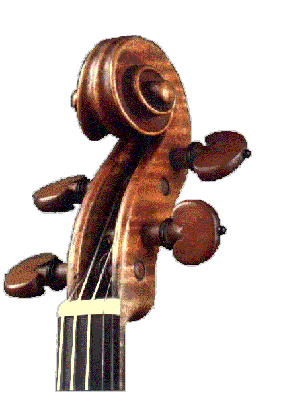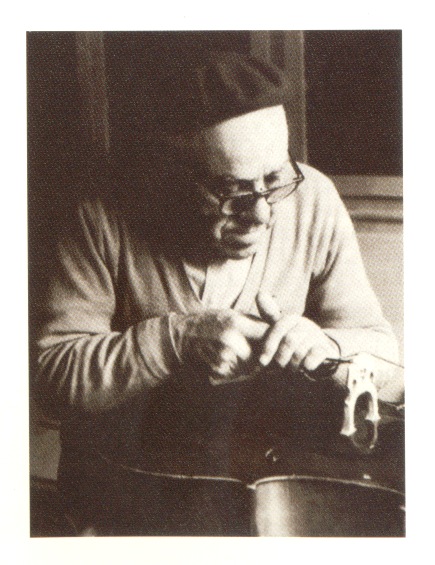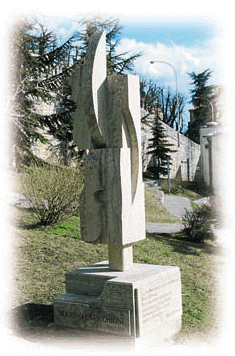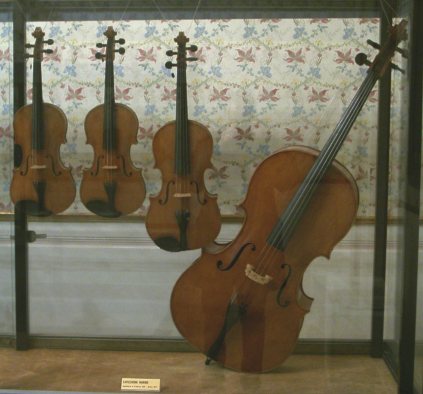MARINO
CAPICCHIONI
 Marino
Capicchioni was born in Santa Mustiola in the Republic of San Marino on
June 28,1895. At an early age worked a local carpenter as a cooper, as
well as a carved and furniture maker. He later developed an interest in
instrument making and constructed several guitars. He completed his first
violin when he was 24. In 1929 he permanently established himself in Rimini
were he opened his own workshop. He participated in numerous exhibitions
and competitions all over Italy and was praised and recognized for his
talent: in 1931 he won the gold medal at the Padua Exposition, and in 1937
he received an honorable mention and a silver medal for his quintet exhibited
in the Cremona competition during the Stradivari Bicentenary.
Marino
Capicchioni was born in Santa Mustiola in the Republic of San Marino on
June 28,1895. At an early age worked a local carpenter as a cooper, as
well as a carved and furniture maker. He later developed an interest in
instrument making and constructed several guitars. He completed his first
violin when he was 24. In 1929 he permanently established himself in Rimini
were he opened his own workshop. He participated in numerous exhibitions
and competitions all over Italy and was praised and recognized for his
talent: in 1931 he won the gold medal at the Padua Exposition, and in 1937
he received an honorable mention and a silver medal for his quintet exhibited
in the Cremona competition during the Stradivari Bicentenary.

The Vannes
Universal Dictionary of Violinmakers quotes that in 1948 Capicchioni had
already made 350 violins, 10 violas and 20 violoncellos. In the middle
of the 1940's his son Mario began working with him and shared in his business
until the Master's death on October 19, 1977.
The Republic of San Marino
dedicated a square to Marino Capicchioni, and erected a monument by the
sculptor M. Busignani Reffi in his honor.

An overall analysis of Capicchioni's
work shop two distinct periods: one to the twenties and thirties and second
"golden period" beginning in the forties, the era witch brought him fame.
An instrument of his period is pictured here.
His work of the twenties
and thirties is distinguished by his continued research for technical and
stylistic solutions: the workmanship is good but his distinct personality
does not emerge. Although he was inspired by the classical models of Stradivari
and Guarneri. In the golden period, the master succeeded in giving a personal
influence to his work, a quality which can be recognized almost unmistakably.
He always used material of an excellent quality and in order to accentuate
the flame of the maple, he developed a special technique for treating the
instrument "in the white". When he varnished his instruments, he attempted
to age them slightly by accentuating the grain of the spruce on the belly.
The varnish used was generally a golden yellow, but one can also find instruments
with a lively red coloring. Capicchioni's work was already quite popular
in the early sixties and his instruments are still sought out today for
their excellent sound.
One of his quartets is on permanent display at the
Stradivari Museum of Cremona.

Various well known musicians have owned his
instruments, including David Oistrach, Yehudi Menhuin, Salvatore Accardo,
Felix Ayo, Pina Carmirelli, Anna Maria Cotogni, Rodolfo Bonucci, Luigi
Alberto Bianchi, Franco Rossi, Amedeo Baldovino and Mstislav Rostropovich.


 Marino
Capicchioni was born in Santa Mustiola in the Republic of San Marino on
June 28,1895. At an early age worked a local carpenter as a cooper, as
well as a carved and furniture maker. He later developed an interest in
instrument making and constructed several guitars. He completed his first
violin when he was 24. In 1929 he permanently established himself in Rimini
were he opened his own workshop. He participated in numerous exhibitions
and competitions all over Italy and was praised and recognized for his
talent: in 1931 he won the gold medal at the Padua Exposition, and in 1937
he received an honorable mention and a silver medal for his quintet exhibited
in the Cremona competition during the Stradivari Bicentenary.
Marino
Capicchioni was born in Santa Mustiola in the Republic of San Marino on
June 28,1895. At an early age worked a local carpenter as a cooper, as
well as a carved and furniture maker. He later developed an interest in
instrument making and constructed several guitars. He completed his first
violin when he was 24. In 1929 he permanently established himself in Rimini
were he opened his own workshop. He participated in numerous exhibitions
and competitions all over Italy and was praised and recognized for his
talent: in 1931 he won the gold medal at the Padua Exposition, and in 1937
he received an honorable mention and a silver medal for his quintet exhibited
in the Cremona competition during the Stradivari Bicentenary.


